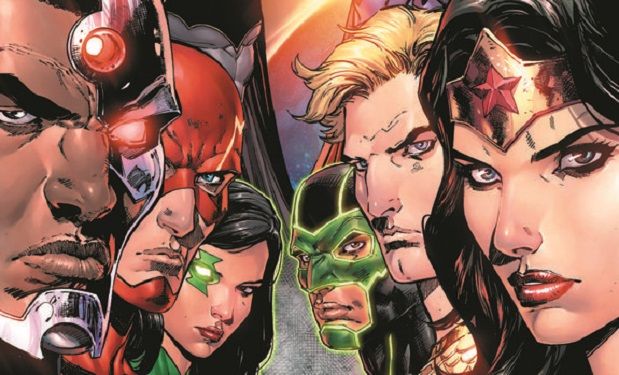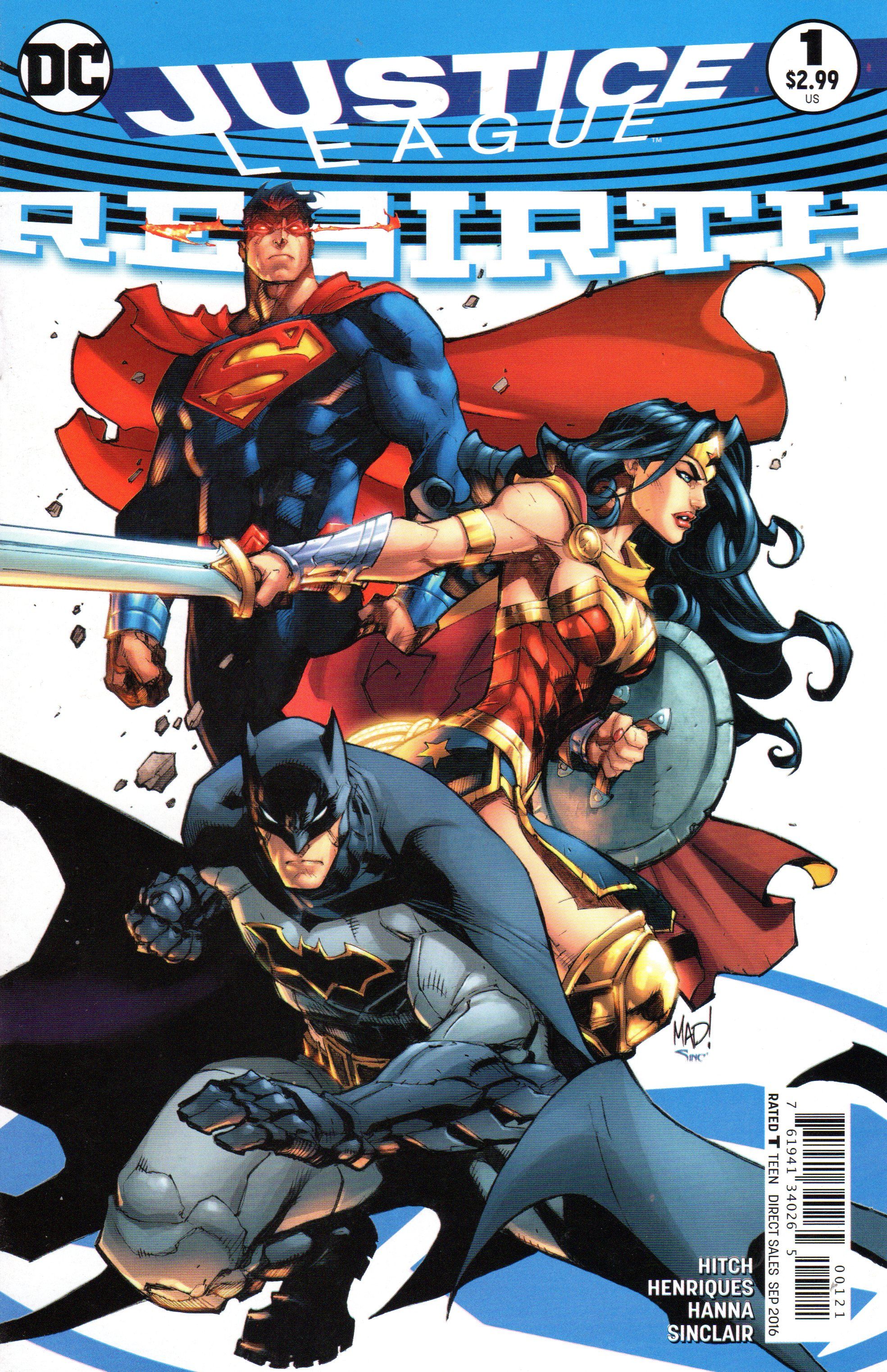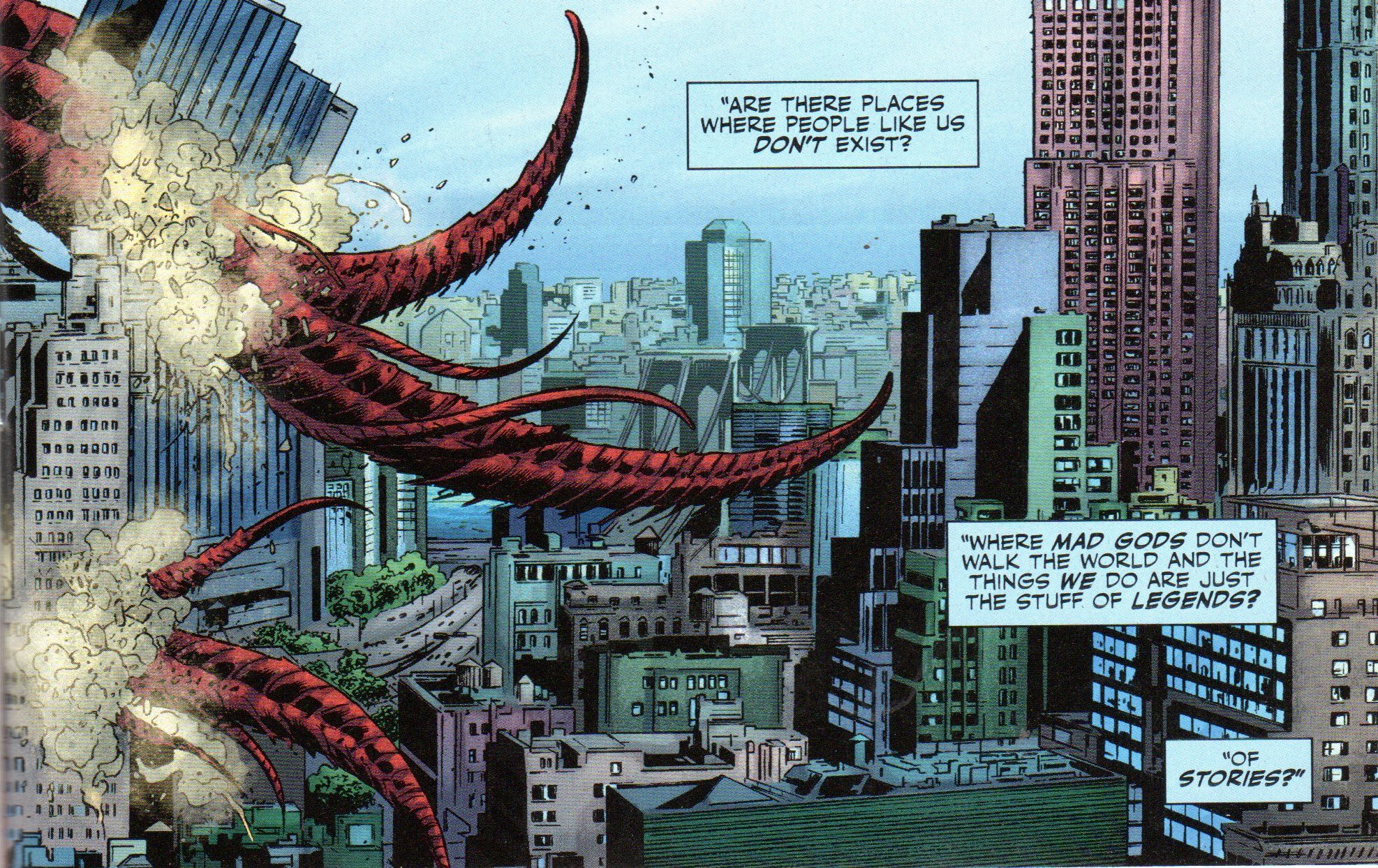After two weeks in which DC released zero (0) actual "Rebirth" titles or #1 issues of new series (some series aren't cool enough to get "Rebirth" titles, I guess), this week we have ... one such title (1). Sigh. Come on, DC, step up your scheduling game!
Justice League: Rebirth ("Fear the Reaper") by Bryan Hitch (writer/artist), Daniel Henriques (inker), Scott Hanna (inker), Alex Sinclair (colorist), Richard Starkings (letterer), Comicraft (letterer), Amedeo Turturro (assistant editor), and Brian Cunningham (editor). $2.99, 20 pgs, FC. Superman and Lois Lane created by Jerry Siegel and Joe Shuster. Batman created by Bill Finger and Bob Kane. Wonder Woman created by William Moulton Marston. Aquaman created by Mort Weisinger and Paul Norris. Barry Allen created by Robert Kanigher and Carmine Infantino. Cyborg created by Marv Wolfman and George Pérez. Simon Baz created by Geoff Johns and Doug Mahnke. Jessica Cruz created by Geoff Johns and Ivan Reis.
The history of comics is often about the history of single creators, a writer/artist dynamo doing his or her thing in some kind of sweatshop or garage or hole somewhere. I read once that Europeans are amused by the "assembly line" method of comics we have in this great land, because they're all sitting around making comics by themselves while they smoke unfiltered cigarettes and eat eels or something (what the hell do I know, I don't live in Europea). But even here in the only country that matters, there's a long list of people cranking out comics by themselves, even though the superhero model is more based on a writer, a penciller, an inker, a colorist, and a letterer. What's interesting is that when someone breaks out of the assembly line, it's usually an artist, not a writer. Writers become writers because they can't draw very well, after all. Most writers, in interviews, are fairly self-aware about their abilities ("I can't draw for shit"). So they get artists to draw for them, and that's where it gets tricky, because you rarely hear an artist say "I can't write for shit." Most artists believe they're writers too, while most writers don't believe they're also artists. So eventually, an artist decides that they can dispense with the writer and do it their own damn selves. And in many, MANY cases, it works out really well. But it's not always the case, as we see with Bryan Hitch. He's not the only one, of course, but he's an interesting case study, because of this comic and the comic that's coming after it.
In a medium that is largely visual, art is much more important than writing, and while I've made that controversial statement before and had people jump down my throat (and it's also something I haven't believed for the entire time I've been reading comics, having reached this conclusion after years of being on the other side of the fence), let's just assume it's true for a moment, especially when it comes to certain artists. One problem I have with artists wanting to be writers is that too often they aren't great writers and eventually they stop drawing, too. Some artists become very good writers and so the loss of their artwork isn't too bad a deal (Wagner, Simonson, even Willingham are examples of this, although the first two are currently drawing series). But Bryan Hitch isn't quite there yet, and who knows if he'll ever be. When you see "Bryan Hitch" on a comic book, you do not immediately think of the amazing prose you're about to read. You think of the widescreen awesomeness you're about to see, and that's the selling point. Justice League: Rebirth gives you that, but Hitch is drawing only this and not the regular series. Is his name enough to get people to buy a Justice League series even if he's not drawing it? Probably, for another reason I'll get to below. But while Bryan Hitch the artist is a known commodity in the comics world, Bryan Hitch the writer isn't. If he were writing AND drawing the book (like he did with the DCnU Justice League thing he was doing), you can forgive his writing foibles a bit more. But if he's not drawing the book and someone like, say, Tony Daniel is, his writing transgressions become more obvious.
The funny thing is, given the mediocre state of superhero comics writing these days, Hitch isn't all that bad. He's not great, of course, but he's not terrible. He knows the formula, in other words, so he knows that he has to make Batman suspicious of Original Recipe Superman but still want him in the League so he can keep an eye on him. Hitch knows that he has to have Superman ramble on about fate and what it means that he's here and Nu-Skool Superman is dead, and he knows how to make Lois say a lot of things about Clark being Superman but not really say anything at all. The appearance of depth is crucial in superhero comics, and Hitch does a decent job with that. He has the superheroes say things that superheroes would say, he has Aquaman play a crucial role because, as you know, Aquaman is really cool, you guys!, and he brings up an interesting (if not terribly original) thought about the Earth and the fact that it's a focal point of every horrible thing in the universe that will not be explored further because it's far too interesting (if I were a betting man; the second thing I would bet on is that Hitch does explore it but doesn't come to any good conclusions about it). So Hitch hits all the beats of a standard superhero comic. He's certainly not the greatest writer, but given the state of superhero comics writing, it's fine.
Of course, his big monster is terrible. Sooooooo many things are wrong with it that I kind of feel bad about it. Let's check them out, shall we?
1. It's called a "reaper." Yes, "reaper" is a great word and a great name for an evil thing, which is why every single person who has ever written a comic has used it for a villain's name.1 If I were a funnier person, I would have already created a webcomic called "Steve the Reaper" in which our titular hero lives his life and gets into goofy situations (he's named "Steve" because of the Scissor Sisters song "Harder You Get," which contains the lyrics "I know the reaper on a first name basis - it ain't Steven" ... yes, I'm a strange dude), but I'm not a funnier person, and so I am sad. But there really ought to be a moratorium on calling something a "reaper" in comics for the next 50 years or so. It's lazy and I have a feeling the only reason Hitch did it was so he could call this story "Fear the Reaper." That's a phrase we definitely need to embargo. It makes every single person on the planet, even 90-year-old North Sentinelese and Paraguayan newborns, think of this:
1 This might be a slight exaggeration. Let's call it 95% of people who have written a comic. Yeah, that's better.
2. The reaper is unimaginably huge. It's an insect that casually strides over Manhattan Island without breaking a sweat. This means Hitch can draw an impressive few panels of it destroying things, but whenever you go that big, the scale threatens to get so out of whack that the threat is, weirdly enough, minimized. The reaper just doesn't feel like a "real" threat because it's so weirdly big. It also makes any defeat of the creature unimpressive, because Hitch can't draw to the scale it would take to defeat the monster. In this issue, he simply draws one panel of all the Leaguers shooting energy at points in the creature's brain (although what Aquaman, Flash, Wonder Woman, and Batman are doing remains a mystery), which makes it retreat. But the panel isn't even that impressive - Hitch wastes a full-page spread at the end of the book when, I would argue, he could have made the tiny Leaguers shooting energy at the creature's brain a really nice, action-packed double-page spread (given DC artists' obsession with full-page and double-page splashes, I'm stunned Hitch didn't go that way). The size of the monster makes the League's victory over it, ironically enough, less impressive. Plus, Hitch has already drawn unimaginably huge creatures as villains in comics before, and more than once. Isn't he a bit tired of it?
3. Its mission is to "reap" humanity. Sigh. Yet another alien presence that, for some random reason, decides that Earth is ripe for the picking. I know it's the Justice League and the threats have to be commensurate with their power level, but this is a really boring plot that has been done so many times before I'm saddened that DC let Hitch run with it.
4. The creature sends out small "antibodies" of some sort that attach to people and subvert their wills. Hitch has done the "antibodies" thing before, in The Authority, and the mind control thing goes back to Starro. It's not only not original, it's boring.
5. I'm fascinated by the pitch process in comics. I assume DC and Hitch had some sort of arrangement whereby he would continue doing Justice League, but did he have to pitch this? If so, didn't anyone at DC say, "Really? Like all the other times we've done a story exactly like this?" Did they not say that because they feared that Hitch would fuck off to Marvel? Again, Hitch is not drawing the regular Justice League title, so how big of a draw is his name for that book anyway? So when he pitched the reaper, did anyone try to stop him or at least get him to modify it just a bit so that it's not so derivative? Or are they just so happy that Hitch is back working for DC that they don't care? Beats me.
The other problem with the comic is Hitch's art, unfortunately. I've been a big fan of Hitch's for years, and while he doesn't draw many comics that I want to read, I still dig his work. I know it's never going to be anything more than superhero spectacle, but he does that really well, and it's fun to see. He does a nice job drawing the reaper walking over Manhattan, and he lays out the fight on the streets pretty well, but then there's the odd choice to minimize the big moment in the book, which is odd considering the final page of the issue is a wasted one of the Justice League that looks like a poster a fan might hang on the wall. It adds absolutely nothing to the story, and once again is probably just there so Hitch can make some money in the original art market. More than that, though, his art looks a bit sloppy at times, as if he was rushed drawing it. I don't know if it's because he was rushing or because Henriques and Hanna didn't ink him as well. Henriques, it seems, has been inking him recently, but I haven't been checking that art out, so I don't know if it's a trend. Hitch's art - when he had time to work on it - was always crisp, and his absolute best work was inked by Paul Neary and - if you want to make the case for The Ultimates - Andrew Currie. So I'm not totally sure if the slight sloppiness of the work - and it's not terrible, just not as good as it used to be - is due to Hitch trying to hit a deadline or his inkers not being as good. And I don't know WHAT'S going on with Wonder Woman's face on Page 7 as she tries to dent the reaper's carapace. That's not a good look.
Ultimately, this entire comic and Hitch's involvement gets to the idea of branding, which is what DC and Marvel are all about these days. We can pretend they're about creators or stories, but they're not. DC wants Hitch's name, but Hitch doesn't want to draw a monthly book, probably because he's not fast enough (which is understandable - it's hard to draw a monthly book). Is Hitch's name as WRITER good enough to make people buy the book? I doubt it. The brand "Justice League" is good enough, especially as DC always starts out any new iteration of the League with characters that people want to see in the book before they let creators bring in Blue Devil or Zatanna and fans stop reading. So why would DC be so keen on keeping Hitch as a writer, when the only compelling reason to read a book with Hitch's name on it is if he's drawing it? I get that they don't want to piss Hitch off, but couldn't they make him see reason? Did anyone buy this comic because Hitch wrote it? No, you bought it because 1. it's part of the Rebirth initiative and you're buying all the Rebirth books; 2. it's the Justice League, which is awesome; 3. Bryan Hitch DREW it. No one will buy the new Justice League title because Hitch is writing it, either. They'll buy it because it's the Justice League and it has a bunch of cool characters. If Tony Daniel can draw it without screwing up too bad (a low bar to set, sure, but he rarely jumps it!) and it Hitch can simply keep the plot from derailing, people will be happy. Because DC is all about the brands. So it would have been nice if they had pushed a bit harder to get Hitch to draw some of it. Hell, maybe he's drawing the next arc and he needs to get that far ahead!
But back to the comic he DID draw - Justice League: Rebirth. Like most of these Rebirth books, it's mediocre. It gives us a threat, dispatches with that threat fairly easily (in the Rebirth issues that have had threats - Batman, Green Arrow, Aquaman - the threats are dealt with really quickly), and sets up the ongoing. Hitch gets us from Point A to Point Z as well as he can, with nothing really standing out. The art is nice but could be better. As with a lot of these Rebirth issues, it's just kind of there. It takes no chances and leaves very little impression. Such is the nature of the beast!
Rating: ★ ★ ★ ★ ★ ½ ☆ ☆ ☆ ☆
One totally Airwolf panel:
It looks like next week I'll actually have THREE new books to check out, which is always nice. DC's scheduling of this Rebirth has been as odd as the initiative itself - I get that they want to spread it out, but man, they're really spreading it out! Be back here to see if Hal Jordan can be interesting and if Chinese Superman is any good!



